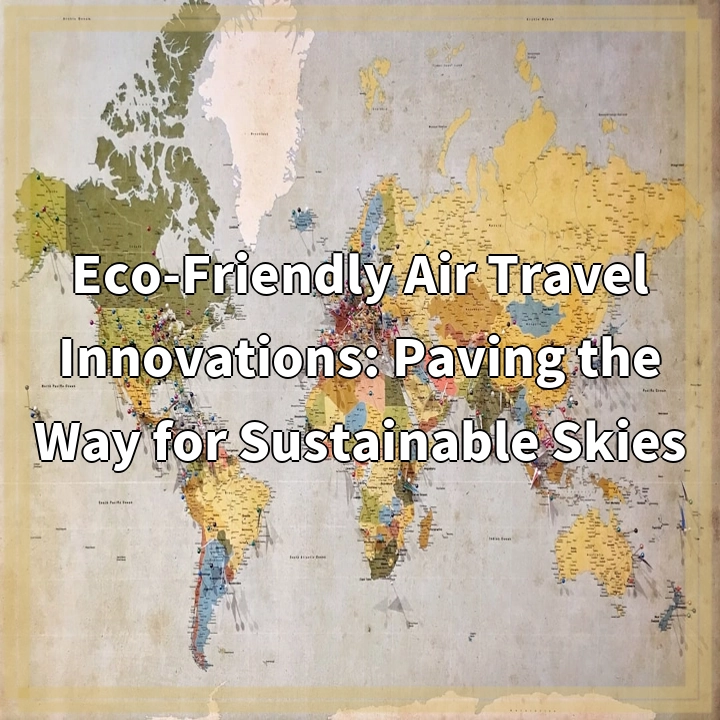
What it is:
Eco-friendly air travel innovations refer to the advancements and technologies being developed to reduce the environmental impact of aviation. These innovations aim to create more sustainable flying experiences by lowering greenhouse gas emissions, minimizing noise pollution, and optimizing fuel efficiency. They encompass a range of areas, including the development of electric and hybrid aircraft, the use of sustainable aviation fuels (SAFs), improvements in air traffic management systems, and the implementation of more efficient flight operations.
Real-World Problems
Despite the promising advancements in eco-friendly air travel, there are several real-world problems that challenge the widespread adoption of these innovations:
1. High Development Costs
Developing and implementing new technologies often require significant financial investments. Many airlines face financial constraints, making it difficult for them to adopt innovative solutions for environmentally friendly air travel.
2. Regulatory Challenges
The aviation industry is heavily regulated, and introducing new technology can undergo lengthy approval processes. This can slow down the pace of innovation and delay the deployment of sustainable solutions.
3. Infrastructure Limitations
The current aviation infrastructure is largely designed for conventional aircraft. Upgrading airports and air traffic systems to accommodate new eco-friendly technologies can be complex and costly, hindering timely adoption.
4. Limited Access to Sustainable Fuels
While sustainable aviation fuels have the potential to significantly reduce emissions, their production is currently limited. The availability, affordability, and scalability of SAFs remain significant barriers to their widespread use in the aviation sector.
5. Public Awareness and Demand
Consumer awareness regarding the environmental impact of air travel is growing, but many passengers still prioritize price and convenience over eco-conscious choices. Encouraging a shift in consumer behavior towards more sustainable travel options is essential for the success of eco-friendly innovations.
6. Technological Limitations
While advancements in electric and hybrid aircraft are exciting, significant technological hurdles remain. Battery density, range limitations, and weight constraints pose challenges for the viability of these aircraft for long-haul flights.
7. Emissions from Existing Fleet
Given that the majority of the global airline fleet is composed of older, less efficient aircraft, emissions reductions from the current fleet remain a pressing issue. Transitioning to newer, eco-friendly technologies may take time, during which substantial emissions continue.
8. Climate Change Impact
The aviation sector is a significant contributor to global greenhouse gas emissions. As climate change concerns escalate, there is growing pressure on the industry to address its impact. However, balancing profitability with sustainability remains a challenge for many airlines.
9. Competition in the Industry
The aviation market is highly competitive, and airlines often prioritize cost-cutting measures over sustainability. Without sufficient market incentives or regulatory support, there may be little motivation for airlines to adopt eco-friendly practices.
In summary, while eco-friendly air travel innovations represent a significant step towards reducing the environmental impact of aviation, various real-world problems must be addressed to unlock their full potential and promote a sustainable future for air travel.

Solutions to Eco-Friendly Air Travel Innovations
Addressing the challenges associated with eco-friendly air travel innovations requires a multifaceted approach involving technological advancements, regulatory support, and consumer engagement. Below are key solutions that can help promote sustainable aviation practices:
1. Government Incentives and Funding
To alleviate the financial burden on airlines, governments can offer incentives for investing in eco-friendly technologies. Grants, tax breaks, and subsidies can encourage airlines to adopt sustainable practices and invest in research and development.
2. Streamlined Regulatory Processes
Regulatory bodies can work to expedite the approval process for new technologies. By establishing clear guidelines and fast-tracking the assessment of sustainable innovations, the aviation industry can more rapidly integrate eco-friendly solutions.
3. Infrastructure Investments
Investments in airport infrastructure and air traffic management systems are crucial to supporting new technologies. Upgrading facilities to accommodate electric and hybrid aircraft, and implementing smart air traffic systems can enhance operational efficiency.
4. Expanding Sustainable Fuel Production
To ensure a steady supply of sustainable aviation fuels, investments in SAF production facilities and research are essential. Collaborations between governments, private sector players, and agricultural sectors can boost the availability and affordability of SAFs.
5. Consumer Education and Awareness
Raising awareness about the environmental impact of air travel can shift consumer behavior toward more sustainable choices. Airlines can engage in marketing campaigns that highlight their eco-friendly initiatives and encourage travelers to prioritize sustainability.
6. Technological Innovation and Collaboration
Encouraging collaboration among industry stakeholders, including airlines, manufacturers, and technology companies, can accelerate the development of innovative solutions. Shared research and joint ventures can lead to breakthroughs in electric and hybrid aviation technologies.
7. Fleet Modernization Plans
Airlines should consider developing modernization plans to replace older aircraft with more fuel-efficient models. Implementing a phased approach to fleet renewal can significantly reduce emissions while enhancing operational efficiency.
8. Strengthening Industry Standards
Establishing industry-wide sustainability standards can promote accountability. By adhering to clear benchmarks for emissions reductions and sustainability practices, airlines can foster a culture of environmental responsibility.
9. Encouraging Sustainable Competition
Creating a competitive marketplace incentivized by sustainability can drive airlines to adopt greener practices. This may involve consumer demand for eco-friendly options and increased pressure from investors for sustainable business models.
By implementing these solutions, the aviation industry can work toward overcoming the barriers hindering eco-friendly air travel innovations and move closer to achieving a sustainable future.















